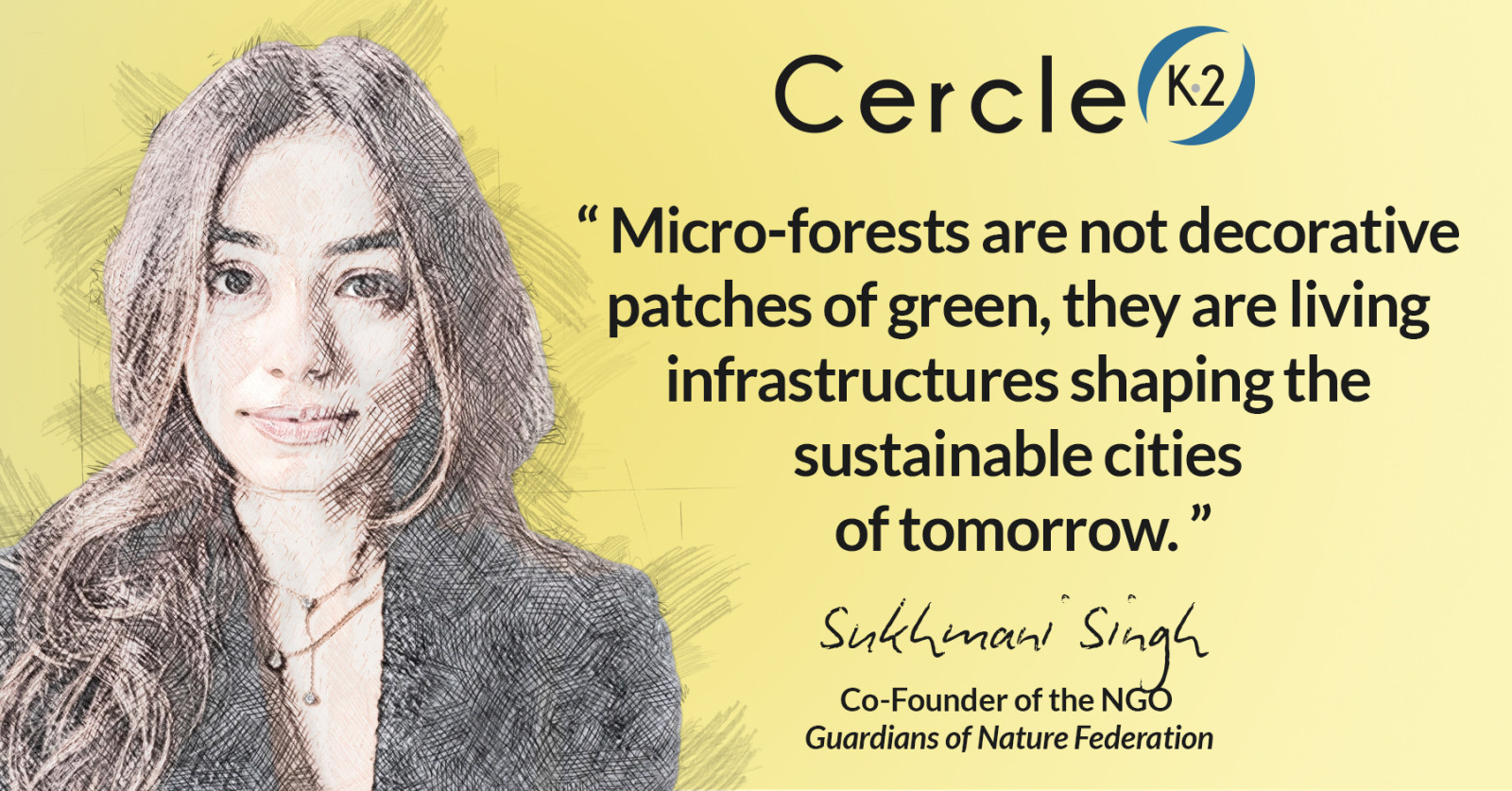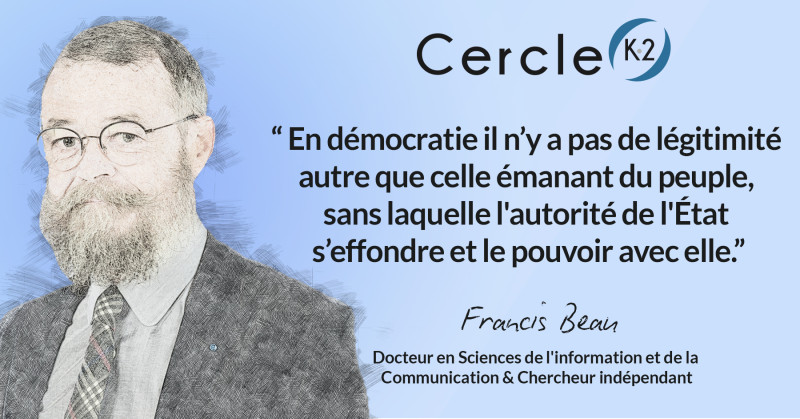Micro-forests: The Essential Policy Tool for Resilient Urban Planning
14/11/2025 - 4 min. de lecture

Cercle K2对所有发布观点既不赞同也不反对,所有观点态度仅属于作者个人。
Sukhmani Singh is Co-Founder of Guardians of Nature Federation, an international NGO based in India.
---
A growing consensus among scientists and policymakers identifies urban micro-forests as an effective, scalable solution to contemporary urban challenges. Designed as compact, biodiverse ecosystems, they offer not only aesthetic value but also tangible infrastructure for climate adaptation, carbon storage, and community well-being, making them essential to the transition toward sustainable and resilient cities.
Micro-forests utilize the Miyawaki method, an accelerated afforestation technique developed by Japanese botanist Akira Miyawaki. The core concept involves planting native trees densely, often three per square meter after conducting field surveys to determine the area’s Potential Natural Vegetation (PNV). This layered approach mimics natural ecological succession to rapidly establish functioning green infrastructure. The speed is significant, with claims of being 10 to 15 times greater over a period of 20–30 years, and aiming to achieve climax forest succession much faster than the 200 years required by traditional methods
I. Context: The Imperative for Urban Green Infrastructure
Cities, home to over 55% of the global population, are central to global climate mitigation efforts. However, they face immense environmental stress: urban areas consume about 78% of the world’s energy and contribute more than 70% of global fossil fuel carbon dioxide (CO₂) emissions. This intense urbanization exacerbates critical phenomena such as the Urban Heat Island (UHI) effect and accelerating biodiversity loss.
The urgency to address these risks is supported by recent economic assessments. Global cities are projected to face the largest economic losses from climate change. The Social Cost of Carbon (SCC) related to urban impacts dominates global estimates, representing about 78% to 93% of the total global SCC. Furthermore, failing to account for local warming (UHI) results in a substantial downward bias in economic loss assessments.
The micro-forest model is uniquely suitable for challenging urban environments and the need for such small-footprint solutions is universal, particularly in constrained historic or central city districts.
II. The High-Impact, Low-Footprint Benefits of Urban Micro-forests These ‘urban mini-jungles’ provide immediate and localized environmental advantages:
- Climate Mitigation and Carbon Sequestration: Urban trees perform crucial environmental functions, including filtering pollutants, mitigating stormwater runoff, and reducing climate change effects by lowering temperatures and storing carbon dioxide. Studies demonstrate that strategically modifying the species composition in urban greening strategies could significantly increase carbon sequestration rates by 47.8%–114% annually. This highlights the importance of species selection in maximizing environmental benefits.
- Thermal Resilience: Micro-forests provide lush shade, mitigating the UHI effect. Research into micro-forests in Cambridge, Massachusetts, found that they were cooler by 20 degrees Celsius (36 degrees Fahrenheit) than surrounding grass during the hottest time of the day. Older Miyawaki plots have also been found to demonstrate less extreme micrometeorology compared to surrounding outside areas.
- Biodiversity and Soil Health: Concentrated plots of greenery restore biodiversity and bring native flora and fauna back into metropolitan areas. They also improve soil fertility, with studies showing that Miyawaki plots exhibit better physical, chemical, and biological characteristics of the soil compared with traditional plots and secondary forests.
Micro-Forests in Action: Global Examples
Micro-forest initiatives are restoring native habitats and providing localized benefits worldwide. At least 40 million trees have been planted across 19 countries through 2,700 projects using this method:
- France: Boomforest initiated projects in Paris (e.g., Porte de Montreuil embankment), Lyon (nine mini-forests), and research projects are underway in Toulouse, Nice (Pledged to the UNECE Trees in Cities Challenge to plant 280,000 trees by 2026 -a five-fold increase and is updating planning policies to use climate-adapted species). Paris City Hall has committed to planting 170,000 trees using the Miyawaki method.
- European Commitments: Nice and Bordeaux have made urban forestry pledges as part of the Trees in Cities Challenge. Geneva has planted its first two urban micro-forests in Switzerland, and Lausanne aims to increase its canopy cover from 20% to 30% by 2040.
- Citizen-Led Projects: Initiatives like Urban Forests in Belgium and Citizens Forests in Germany emphasize a citizen-led focus, while Earthwatch Europe has planted over 200 small forests in the United Kingdom and mainland Europe.
- India: 20 microforests are established in New Chandigarh, Punjab by the NGO Guardians of Nature Federation. The ‘My village, My forest’ pilot project in Fazilka district, Punjab, aims to establish 75 micro-forests. A Miyawaki plantation was also established at Saurashtra University Campus in Rajkot to investigate ethnobotanical and pharmacological values.
- China: The megacity of Shenzhen is a case study for new carbon monitoring frameworks, and Shanghai has assessed Miyawaki plots over a 10-year recovery period.
- California: Micro-forests are being planted in Los Angeles (LA Microforests) and Griffith Park) and Berkeley (Urban Pocket Forest).
- Northeast/ Midwest U.S.: Initiatives are also underway in Cambridge, Massachusetts (Danehy Park Forest) and St. Paul, Minnesota (Rondo neighbourhood).
III. Policy Integration: From Philanthropy to Mandatory Infrastructure
Micro-forests should be viewed not as merely green amenities but as an essential cornerstone of formal urban policy and mandatory master planning building climate- adaptive infrastructure. Policy must mandate the allocation of space for these ecological interventions, compelling planners to define urban space in terms of planetary health.
Policymakers and urban planners are strongly encouraged to formally integrate minimum quotas for dense, native afforestation into all municipal development strategies, ensuring the necessary shift toward public, green-centric spaces occurs now, for the collective benefit of urban society. The urgency for this is underscored by the finding that stringent mitigation of greenhouse gases is in the best interest of urban regions worldwide.
However, the implementation of such policies must be nuanced, recognizing key constraints:
- Spatial Limitation: Planting trees to increase canopy coverage is particularly challenging in dense urban centres, where infrastructure often limits greenspace. This requires addressing the limitations of rigid urban planning models, such as those that attempt to freeze city development for decades. Instead of exclusively focusing on roads for vehicular transit, planning must prioritize defining urban space in terms of streets for people, interaction, and planetary health. For instance, analysis in historical districts of 15 Polish cities revealed that actual tree canopy coverage ranged only from 15% to 34%, despite a calculated potential of 31% to 51%. This means that maximizing ecological impact often requires strategic species selection based on the geographical area over pure quantity.
- Investment Cost: The Miyawaki method is characterized by a large initial capital investment compared to classical reforestation techniques. Research indicates that the carbon sequestration rate of Miyawaki forests is approximately 10-15 times greater than that of natural regeneration over a period of 20-30 years. Therefore, given its significantly accelerated ecological benefits, it is important to include the Miyawaki method in strategic policy budgets for effective and high-impact urban carbon reduction initiatives.
- Governance Structure: Successful micro-forest deployment often stems from community-driven and localized engagement. This mandates decentralized governance through multi-stakeholder partnerships involving local authorities, NGOs, and community groups.
- Functional Well-being and ESG Alignment: For urban management, the ‘well-being’ of a city rests on its optimal functional performance. Solutions would take into consideration factors like the shift in emission model from industrial production focused sectors (Scope 1) to consumption based end users like residential and commercial buildings (Scope 2). In addition to implementing targeted solutions like energy efficiency measures for these consumption-led areas, integrating these living systems into project designs, local governments embed sustainability metrics that enhance the long-term resilience and functional vitality of the urban landscape.
Furthermore, policies should leverage GIS-based tools for optimizing these spatially complex mitigation strategies to fit local conditions and aid transparent integration into the national carbon budget.
Prioritising these green, people-centric spaces today is the most strategic investment policy can make for the sustainable and resilient cities of tomorrow.
---
List of References:
1. Zhu, Yiwen & Zhang, Yuhang & Zhang, Yi & Zheng, Bo. (2025). Tracing CO2 emissions across megacity landscapes: beyond citywide totals to structural heterogeneity and mitigation. Environmental Science and Ecotechnology. 27. 100602. 10.1016/j.ese.2025.100602. Link
2. Kacprzak, Malgorzata & Ellis, Alexis & Fijałkowski, Krzysztof & Kupich, Iwona & Gryszpanowicz, Piotr & Greenfield, Eric & Nowak, David. (2024). Urban forest species selection for improvement of ecological benefits in Polish cities - The actual and forecast potential. Journal of environmental management.366. 121732. 10.1016/j.jenvman.2024.121732. Link
3. https://unece.org/media/press/365714
4. Monteiro, Barbara, "WHAT IT TAKES TO GROW A MICRO FOREST AT NEW COLLEGE OF FLORIDA" (2023). Theses & ETDs. 6404. Link
5. Zeybek, Osman. (2025). Evaluating the Miyawaki Afforestation Technique in Urban Landscapes: Opportunities and Challenges. Iconarp International J of Architecture and Planning. 13. 313-337. 10.15320/ICONARP.2025.326. Link
6. Estrada, Francisco & Lupi, Veronica & Botzen, W.J. & Tol, Richard. (2024). Urban and Non-Urban Contributions to the Social Cost of Carbon. 10.21203/rs.3.rs-4671262/v1. Link
7. Kim, Soo-Yeon & Kerr, Gaige & Donkelaar, Aaron & Martin, Randall & West, Jason & Anenberg, Susan. (2025). Tracking air pollution and CO2 emissions in 13,189 urban areas worldwide using large geospatial datasets. Communications Earth & Environment. 6. 10.1038/s43247-025-02270 Link
8. Link
14/11/2025















